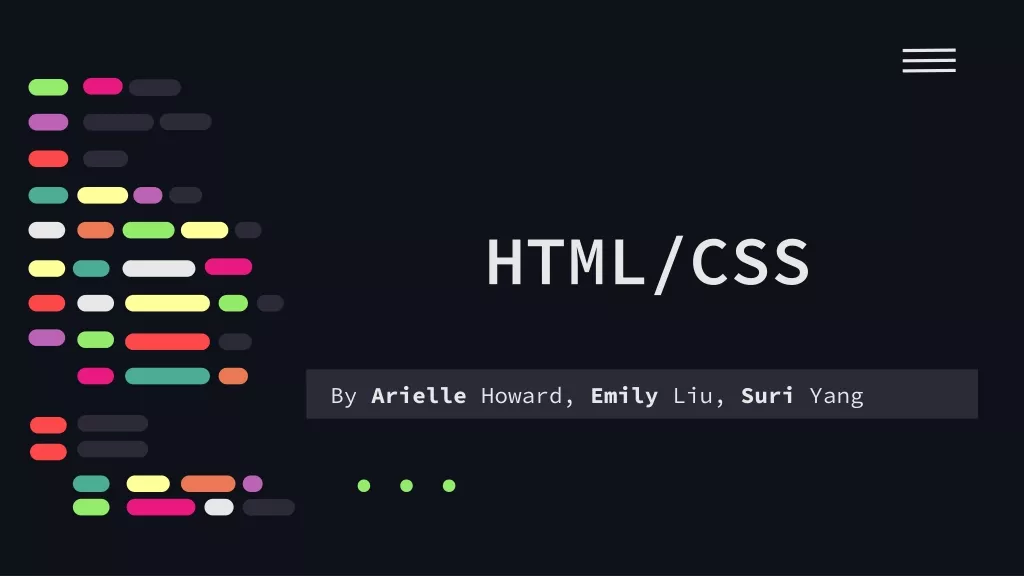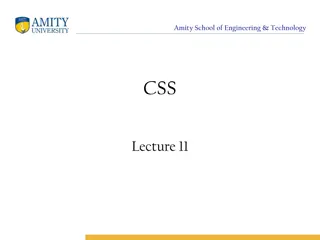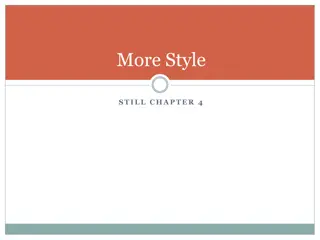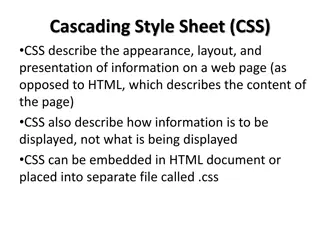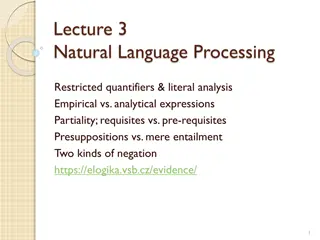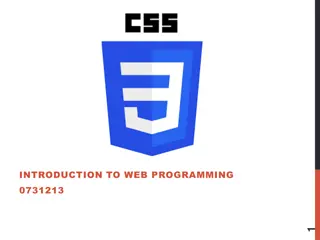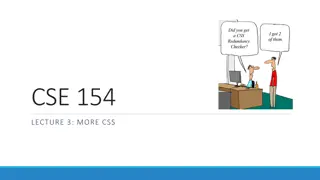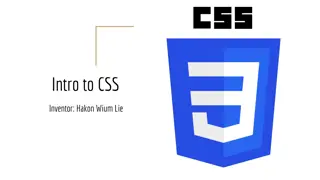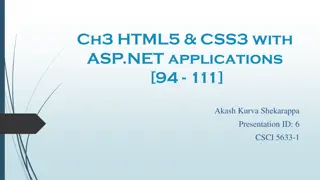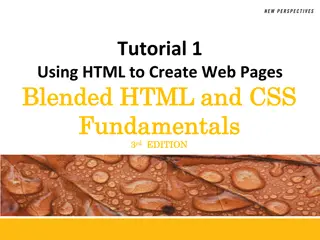Empirical Study on CSS Preprocessors: Insights and Findings
Exploring the utilization of CSS preprocessors in web development through an empirical study conducted by Davood Mazinanian and Nikolaos Tsantalis from Concordia University. The study delves into the motivations behind using CSS preprocessors, developers' preferences, features offered by preprocessors, and practical applications in website design. It also investigates the challenges faced and potential benefits in adopting preprocessors for improved styling of web content. Overall, the research sheds light on the significance of CSS preprocessors in enhancing the efficiency and flexibility of front-end development practices.
Download Presentation

Please find below an Image/Link to download the presentation.
The content on the website is provided AS IS for your information and personal use only. It may not be sold, licensed, or shared on other websites without obtaining consent from the author.If you encounter any issues during the download, it is possible that the publisher has removed the file from their server.
You are allowed to download the files provided on this website for personal or commercial use, subject to the condition that they are used lawfully. All files are the property of their respective owners.
The content on the website is provided AS IS for your information and personal use only. It may not be sold, licensed, or shared on other websites without obtaining consent from the author.
E N D
Presentation Transcript
An empirical study on the use of CSS Preprocessors Davood Mazinanian - Nikolaos Tsantalis Department of Computer Science and Software Engineering Concordia University - Montreal
Agenda Introduction to CSS and CSS preprocessors Motivation The main research question: How developers use CSS preprocessor features? 2 / 24
Cascading Style Sheets (CSS) The standard styling language Target documents selector { property: value; } Declaration Limitations of CSS Was initially designed for non-developers! Duplication is pervasive! Introduction Motivation Empirical Study 3 / 24
CSS Preprocessors Super-language for CSS for generating CSS Adding missing features: Variables, functions, loops, conditional statements, mathematical operations, etc. Introduction Motivation Empirical Study 4 / 24
Motivation Which preprocessor do they prefer? What percentage of developers use preprocessors? Not used 46% Less 51% Sass 41% Used 54% Stylus 6% Other 2% Credits: css-tricks.com/poll-results-popularity-of-css-preprocessors/ Introduction Motivation Empirical Study 5
Motivation Collecting information to: Support devising automatic migration techniques Support developing preprocessor refactoring approaches Introduction Motivation Empirical Study 6 / 24
Empirical Study Subjects 80 websites (40 websites for Less, 40 for Sass) 220 Less and 738 Sass files (total 958 files) Found preprocessor files using Google! E.g.: filetype:less AST Results Parse Query Analysis LESS SASS CSV files Introduction Motivation Empirical Study 7 / 24
Feature #1: Nesting Goals: better organization, avoiding duplication in selector names table { } table { border: none; outline: 0; border: none; outline: 0; &:hover { } td { margin: 3px; } } Preprocessor table:hover { font-weight: bold; } font-weight: bold; table td { margin: 3px; } CSS Introduction Motivation Empirical Study 8 / 24
Feature #1: Nesting By far the most-used feature of CSS preprocessors! Out of all 34065 selectors, 21870 are nested, or have nested selectors (65%) Question: Are they used even for shallow nesting? Introduction Motivation Empirical Study 9 / 24
Feature #1: Nesting How deep was nesting? Introduction Motivation Empirical Study 10 / 24
Feature #1: Nesting Conclusions Every migration tool / technique should support migration to nesting ! Developers nest selectors, even if the level of nesting is not very deep! Introduction Motivation Empirical Study 11 / 24
Feature #2: Mixins Goal: increasing re-usability and comprehensibility of code table { margin: 5px; border: solid 1px black; border-radius: 3px; outline: ridge black 0; } table { margin: 5px; .border(1px, 3px, 0) } .border(@b, @r, @o) { border: solid @b black; border-radius: @r; outline: ridge black @o; } Preprocessor CSS Introduction Motivation Empirical Study 12 / 24
Feature #2: Mixins Mixin calls: how much re-usability? Introduction Motivation Empirical Study 13 / 24
Feature #2: Mixins Size of Mixins 80% of Mixins have less than 5 declarations Introduction Motivation Empirical Study 14 / 24
Feature #2: Mixins Size of Mixins Introduction Motivation Empirical Study 15 / 24
Feature #2: Mixins Number of parameters 30% 31% 25% 36% Introduction Motivation Empirical Study 16 / 24
Feature #2: Mixins Parameter re-use Mixins with parameters used in more than one type of declaration .mixin(@param1) { top: @param1; margin-left: @param1 } Sass: 13% Less: 18% # Parameters and # declarations inside Mixins are not correlated Spearman Rho = 0.17 with p-value = 3.471e-05 Introduction Motivation Empirical Study 17 / 24
Feature #2: Mixins 65% of Mixins are used for cross-browser declarations! .rounded(@radius: 2px) { -webkit-border-radius: @radius; -moz-border-radius: @radius; border-radius: @radius; } Introduction Motivation Empirical Study 18 / 24
Feature #2: Mixins Conclusions Mixins having cross-browser declarations are preferred Perhaps because they have greater impact on minimizing duplication (to be researched) Mixins do not tend to have Large number of parameters Large number of declarations Thus, it is not preferred to have large Mixins with too many parameters Introduction Motivation Empirical Study 19 / 24
Feature #3: Extend Minimizing duplication by grouping selectors table { float: left; } table { float: left; &:extend(.zeroSpacing) } .zeroSpacing , table { margin: 0; padding: 0; } .zeroSpacing { margin: 0; padding: 0; } Preprocessor CSS Introduction Motivation Empirical Study 20 / 24
Feature #3: Extend Much less used than Mixins No usages in the Less dataset, Only 15% of Sass files had an Extend usage inside Reason: order dependencies Using Extend will change the order of the selectors that may lead to breaking the presentation Introduction Motivation Empirical Study 21 / 24
Feature #3: Extend Breaking the presentation by using Extend! table { float: left; } table { float: left; &:extend(.zeroSpacing) } table { margin: 2px; } table { margin: 2px; } .zeroSpacing, table { margin: 0; padding: 0; } .zeroSpacing { margin: 0; padding: 0; } Preprocessor CSS Introduction Motivation Empirical Study 22 / 24
Feature #3: Extend Conclusions Prefer to use Mixin instead of Extend Even though it may produce more duplication in the resulting file If removing duplication by using Extend, check the overriding dependencies! Introduction Motivation Empirical Study 23 / 24
Summary Using preprocessors is a trend! Developers use Nesting whenever possible! Mixins: Are short (less than 5 declarations), Mostly have zero or one parameters Are usually used for cross-browser declarations! Developers prefer using Mixins over Extends! It is not always safe to use Extend 24 / 24


